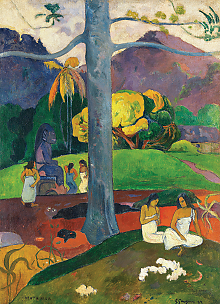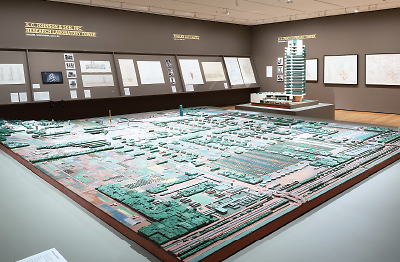Spend a Day or Night at the Museum
Abstract
This spring, several of the museums that people travel from around the globe to visit will be mounting particularly fascinating exhibits.

Paul Gauguin, whose 1892 work, Mata mua (In Olden Times) is shown above, is the subject of a Museum of Modern Art exhibit on his experiments with various media, including woodcuts, paper, and large transfer drawings.
Whether you are a lover of the visual arts, an ancient-history buff, or a devotee of science and its many mysteries, New York museums will provide an array of tempting diversions in your time away from the annual meeting’s scientific sessions.
A real treat awaits at the Museum of Modern Art (MoMA) this spring, especially for those interested in architecture, with the exhibit “Frank Lloyd Wright and the City: Density vs. Dispersal,” which “examines the tension in Wright’s thinking about the growing American city in the 1920s and 1930s, when he worked on radical new forms for the skyscraper and on a comprehensive plan for the urbanization of the American landscape titled ‘Broadacre City.’ ” Included is a huge 12-foot-by-12-foot model of the plan, complete with highway flyovers and farm areas.
Also at MoMA is an exploration of about 150 of Paul Gauguin’s prints and transfer drawings in the exhibit “Gauguin: Metamorphoses.” The museum notes that “these remarkable works on paper reflect Gauguin’s experiments with a range of mediums, from radically ‘primitive’ woodcuts that extend from the sculptural gouging of his carved wood reliefs to jewel-like watercolor monotypes and large, mysterious transfer drawings.”
The Metropolitan Museum of Art is so vast—it’s four blocks long—and its collections so deep—encompassing more than 2 million works—that it’s best to pick up a guide at the information desk and concentrate on just a few favorite periods or styles. The Met is perhaps best known for its extensive collections of ancient, Medieval, and Renaissance art and artifacts. It’s Egyptian collections are especially renowned. But a museum visitor can also take a geo graphic approach, choosing gallery destinations that include the art of the Near East, Africa, Oceania, Asia, and ancient Greece, Rome, and Etruria.
Museum of Modern Art
11 W. 53rd Street
Metropolitan Museum of Art
Fifth Avenue at 82nd Street
American Museum of Natural History
Central Park West at 79th Street
Among the special exhibits that the Met will mount during the annual meeting is one with the somewhat unwieldy title “The Nelson A. Rockefeller Vision in Pursuit of the Best in the Arts of Africa, Oceania, and the Americas.” Rockefeller, who died in 1979, was a former U.S. vice president, four-time governor of New York, and scion of one of America’s richest families who wanted to do something about the Met’s lack of depth in art from these areas and establish them as part of the tradition of producing and collecting fine art. His collecting led to the establishment of a wing of the museum to house these works.
Another exhibit sure to draw large crowds is “Fabergȳ From the Matilda Geddings Gray Foundation Collection.” Gray was a Lousiana heiress who began acquiring works by Russian artist and jeweler Peter Carl Fabergȳ in 1933. She eventually compiled one of the world’s largest assemblages of his work, many of them commissioned by the Romanov family of Russian czars. Three of the famed imperial Easter eggs are on view, among many others of his intricate jewel-encrusted creations. This is the first time Fabergȳ works have been on view to the public in New York since 2004.
A very different viewing experience is available at the American Museum of Natural History—one in which the wonders of science are made fun and exciting for all ages.

In the 1920s and 1930s, famed architect Frank Lloyd Wright developed a detailed vision of what he thought the American city of the future would look like. The Museum of Modern Art exhibit “Frank Lloyd Wright and the City: Density vs. Dispersal” explores that vision in a huge model and multiple drawings.
How much more intriguing could an exhibit title be than “The Power of Poison”? This exhibit “explores poison’s paradoxical roles in nature, myth, and human health—as a defense against predators, source of strength, or lethal weapon-turned-lifesaving treatment.” One section, for example, pulls back the curtain on myths about enchantment or death by poison that actually contain some truth to them. Another delves into “some of history’s most intriguing poison cases,” several of which continue to baffle researchers and forensic scientists. Visitors can also participate in “a live presentation about a real-world poisoning case and key advances in toxicology,” the museum notes.
Exhibit halls are also dedicated to the museum’s vast collection of fossils, including its famous dinosaur exhibits; birds, reptiles, and amphibians; and biodiversity and the environment.
If you want to give your feet a rest, a spectacular film at the museum may be just the tonic you need. “Mysteries of the Unseen World”—shown in 3D or 2D—takes viewers “into earthly worlds secreted away in different dimensions of time and scale,” the museum notes. “Viewers will experience events that unfold too slowly for human perception; they will enter the microscopic world that was once reserved only for scientists.” The film uses high-speed and time-lapse photography, electron microscopy, and nanotechnology to convey its message about “the wonder and possibilities of science.” ■



